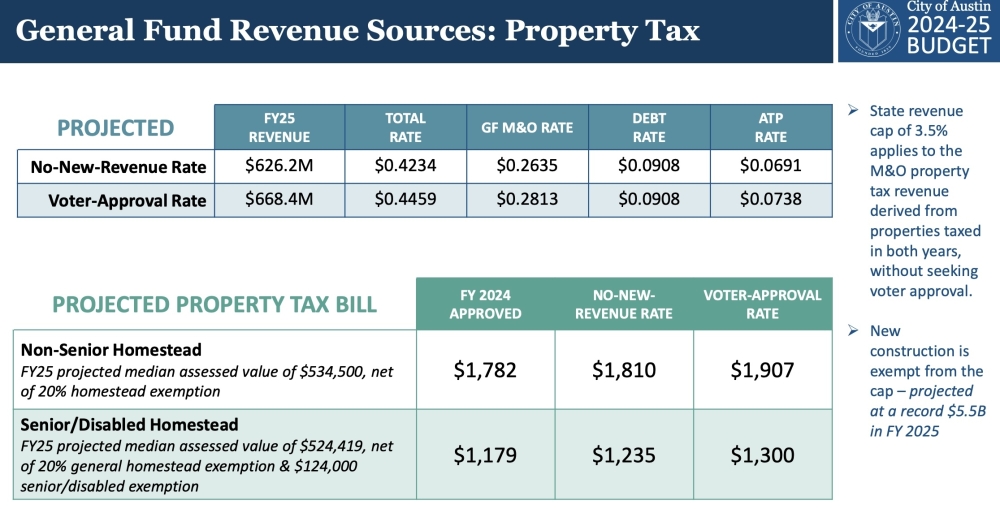Financial analysts projected a $3.8 million budget shortfall to close out fiscal year 2023-24, which ends Sept. 30.
“The anticipated deficit will limit our opportunity to fund any new initiatives, program enhancements or additional staff,” Garza said.
The overview
City staff and a financial consultant shared a five-year economic forecast with City Council on April 16 to kick off the budget process. Austin is projected to end FY 2023-24 with $1.4 billion in the bank, which is $3.8 million less than leaders budgeted for.
The projected shortfall is due in part to stagnant sales tax revenue. City Budget Officer Kerri Lang said sales tax returns are expected to hit $358.7 million by the end of the fiscal year—$16.9 million below previous estimates.Sales tax revenue has grown by 1.5% so far this fiscal year, Lang said.
“We were budgeted at 3.1% growth for fiscal year [2023-24]. But because of the [FY 2022-23] actuals being less than our anticipated budget, we estimate we need 4.8% growth in order to meet this current year's budget,” she explained.
Financial staff said they expect to see more sales tax growth in the upcoming fiscal years.
Austinites’ property tax bills are expected to increase during the next fiscal year, according to the presentation from city staff. This year, residents whose homes are valued at $534,500—the local median appraised value—would pay $1,782 in property taxes. Next year, they could pay over $1,900 if voters approve a higher tax rate.

The projected changes for FY 2024-25 include:
- Austin Energy: All customers would see 2% annual rate increases through 2027.
- Austin Resource Recovery: The average customer’s monthly bill would increase by $1.55.
- Austin Water: The average customer’s monthly bill would increase by $7.76.
- Development Services Department: The department’s portion of the Clean Community Fee would increase by 30 cents for all customers. The fee is split between Austin Resource Recovery and the DSD.
- Transportation and public works: The transportation user fee, which helps repair streets and fill potholes, would increase by 91 cents for the average customer.
- Watershed protection: The drainage utility fee would increase by $1.45 for the average customer. The fee is used to maintain city drainage infrastructure, and mitigate erosion and water pollution.
Lang also laid out expected cost increases for the city. Officials plan to increase wages for city employees by at least 3% each year and raise health insurance benefits by 10%. Combined with projected labor contracts for public safety employees, these changes would cost the city about $46 million for FY 2024-25.
The city expects to spend $2.7 million to hire 16 new firefighters and 12 paramedics when the new Canyon Creek fire and emergency medical services station opens in Northwest Austin this fall.
Additional costs include $10.3 million to support growth within the city’s human resources, financial services, legal and other departments; $800,000 to open the new Colony Park Pool and reopen the Givens Pool after renovations; $700,000 to expand the Mexican American Cultural Center; and $400,000 for food, medical supplies and other services at the Austin Animal Center.
Also of note
City leaders also have to budget for the end of one-time federal funding from the American Rescue Plan Act.
Austin received $188.5 million in ARPA funds during the height of the COVID-19 pandemic, which officials have put toward tackling homelessness, boosting workforce development, supporting child care programs and more.
All the funds must be allocated by the end of 2024 and spent by the end of 2026, potentially leaving certain initiatives without funding. As of January, around $31 million had not been spent, Lang said.
"We’re not going to leave anything on the table, but there are going to be some critical policy decisions coming up during that period of time about this elevated level of spending and whether or not, when that money starts to dry up, if we’re going to go back to pre-COVID[-19] levels of funding or if we’re going to try to maintain those elevated levels of spending. And if so, how does that look relative to our ability to do so, relative to our revenue,” Chief Financial Officer Ed Van Eenoo said during a Feb. 27 meeting.
Dates to know
According to a post from Mayor Kirk Watson on the city message board, City Council will use the following timeline to create the city’s FY 2024-25 budget:
- July 12: Incoming City Manager T.C. Broadnax and his staff will present a draft budget to City Council. Broadnax will take over for Garza on May 6.
- July 24: Officials will hold a public hearing on the budget, followed by a City Council work session to discuss the general fund.
- July 30: City Council will receive a briefing on enterprise funds and the Capital Improvement Program during a work session.
- Aug. 1: City Council will hold a second public hearing and set the maximum property tax rate for FY 2024-25.
- Aug. 5: Approximate deadline for council members to submit budget amendments and proposed policy changes
- Aug. 6: City Council and staff will meet to review the proposed changes. This meeting may be canceled.
- Aug. 8: City Council will hold its final budget work session to discuss council members’ proposals.
- Aug. 14-16: City Council will vote on adoption of the budget, all proposed amendments and other policy changes.





